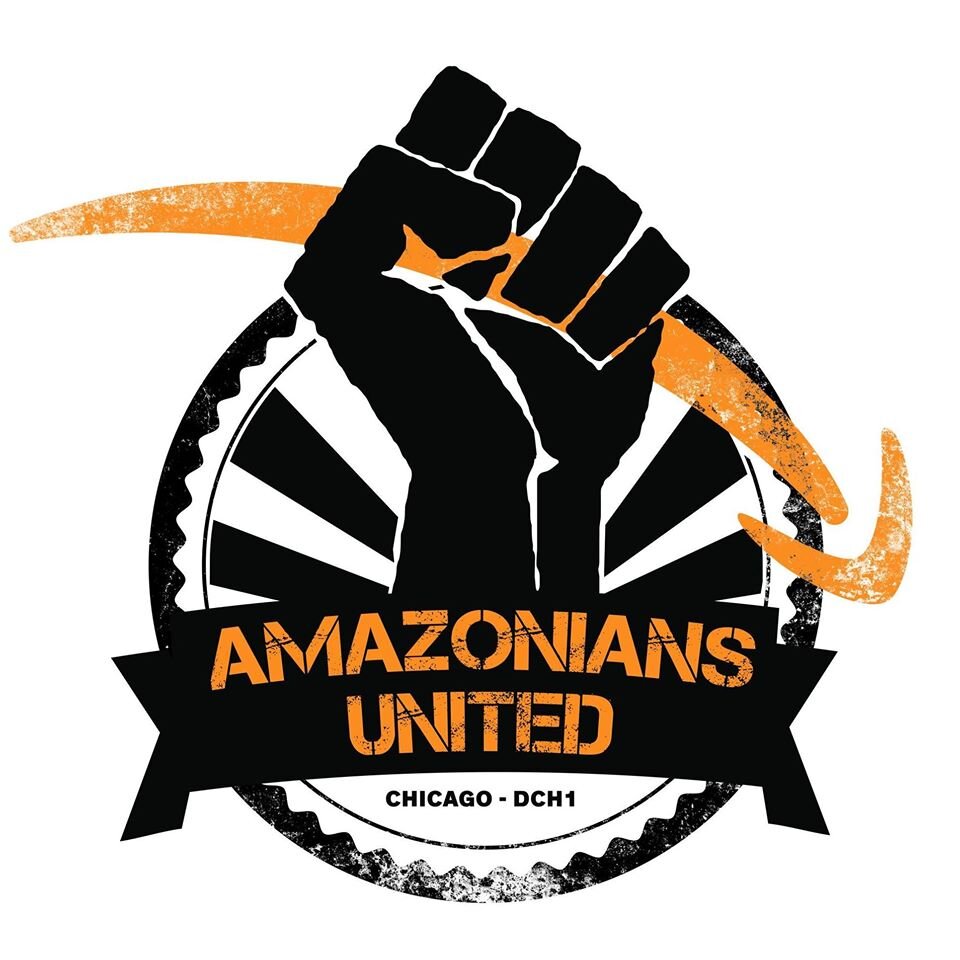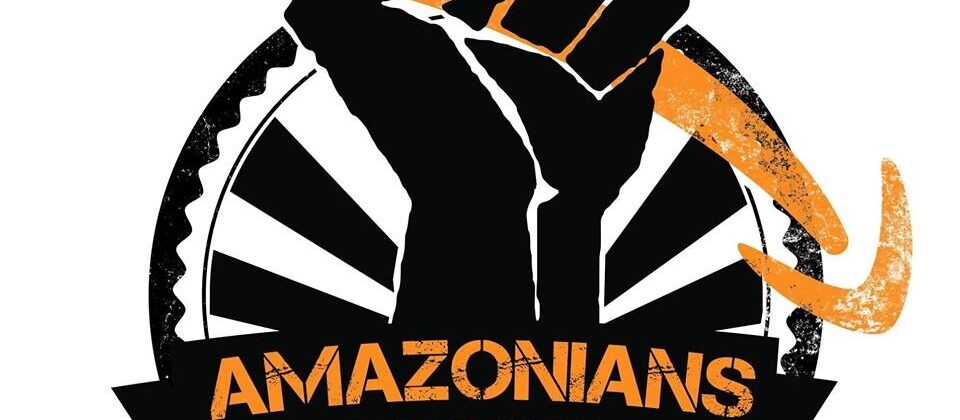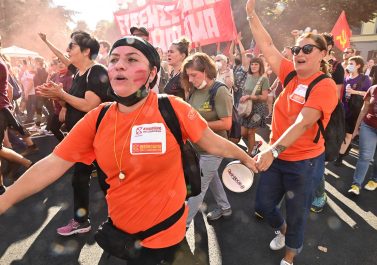
(translated from Wildcat no.108)
On April 7, 2021, dozens of workers went on strike at a new Amazon distribution center in Chicago. One of them sent us a short report about their actions and the backstory of their organizing.
In 2019, we started with a small nucleus at Chicago’s DCH1 distribution center. [1] We took on a demand – access to drinking water – that was very basic and widespread. How ridiculous and illegal it would have been for Amazon to kick us out for demanding water! We won on this issue and continued to organize, growing our organizing committee and resisting Amazon’s attempts to appease and co-opt us. In every collective action, we made sure that many colleagues participated directly or had our backs.
2020 was a wild ride that shaped us, a formative year of great growth for our union, Amazonians United (AU). To kick off 2020 we joined the first national, cross-site campaign of Amazon workers in the US: Amazonians United for PTO (paid time off). Through this campaign, initiated by AU Sacramento, taken up by us in Chicago and later joined by the newly formed AU NYC, we won PTO for all part-time Amazon workers. Then in March, just as the pandemic was exploding, we attended the international convention of Amazon workers in Spain and joined our comrades in launching our international network: Amazon Workers International.
When we returned to the US, AU NYC was in the process of initiating what became an international Amazon worker petition campaign for Coronavirus Protections. We joined our fellow NYC co-workers in formulating the demands and spreading the petition, and were inspired by their courageous walkouts and shutdowns of their Delivery Station when covid started spreading at their worksite. When covid hit our facility in Chicago, we too took militant collective action against Amazon, organizing 4 shift-long majority-participation safety strikes demanding management accept and implement our coronavirus protections demands. Amazon had to delay the delivery of more than 50% of their packages during the days we went on strike. The volume was backed up and DCH1 was a mess the whole week.
Amazon did not shut DCH1 down as we demanded, but after our safety strikes, Amazon permanently reduced the volume at our facility by about 50% and finally started providing us with the appropriate PPE. Our safety strikes were powerful collective actions–we had our site lead nervously threatening us with termination and screaming at us to get off the property through the speakers of a cop car. Everyone saw him trembling and backing up into a corner with fear of workers in his eyes, and this made us feel strong. It was tough, but we stayed united despite Amazon’s retaliation and we made sure that no co-worker got fired for striking.
Conditions at DCH1 became strange after our safety strike. From May 2020 – April 2021 (the month DCH1 closed), the volume at our facility dropped down to 20% of our regular volume. Our facility became super overstaffed. 80 workers would be scheduled to work but management would only have work for 25, so they would offer VTO (voluntary time off) multiple times a night. Most co-workers would accept the VTO, but many of us wouldn’t so then managers would give us useless busywork for the whole shift, like putting tape on the floor or moving empty carts around. During this time period, Amazon wouldn’t have any work for us to do for half of our shift, so we would just sit around talking with each other. We suspected something was going on, but we didn’t know what. Management wouldn’t tell us anything, all we had was rumors.
In September 2020 Amazon began the process of closing DCH1 by forcing our “seasonal” co-workers to transfer to the newly built Chicago Delivery Stations. Amazon had been very busy before and throughout the pandemic building and opening many new Delivery Stations throughout our city and the US. Just within the past two years, Amazon opened at least 8 new facilities in the Chicagoland area, and they continue building more! We started organizing a struggle against these forced transfers, but we did not have enough collective power at our single site to stop these injustices that were part of Amazon’s nationwide expansion. Amazon is building out it’s logistics network at such a fast pace to both increase the speed of package delivery and to rapidly increase the percentage of packages that Amazon delivers through its own delivery stations, as opposed to using UPS or USPS.
In April 2021 Amazon closed DCH1, the Delivery Station where we founded Amazonians United. We were all forced to transfer to one of the new Delivery Stations they had just built. Many things changed together with this closure and our transfer. The most significant change is our schedule. The “Megacycle,” a 10 hour shift from 1:20am – 11:50am, is now the standard and only shift at Delivery Stations. This is very different from before when Delivery Stations were a 24/7 operation with hundreds of part-time workers and, excluding management, zero full time workers. Now Delivery Stations only offer full-time positions for this shitty megacycle shift. Many co-workers, especially mothers, were fired because these hours are impossible for them.
Now, Amazon Delivery Station jobs in the megacycle are considered by workers as “main jobs,” whereas before Delivery Station jobs were a “side” job for many workers. At the same time, Amazon has finally given us pay raises, implemented tenure-based automatic pay increases, and increased our shift differential for working the night shift from a miserable $0.50/hr to a slightly less miserable $1.50. Like always, this betterment of pay didn’t come from Amazon’s generosity. Rather, it came from Amazon’s difficulty in retaining workers and it came as a result of our collective action. The increase in shift differential was one of our 4 demands in our “megacycle accommodations” petition. On April 7th, Amazonians United at DIL3, one of the new facilities which had just opened up, walked out 4 hours before their shift ended to show management who needs who and that we’re serious about our demands. Less than a month later we got the “great news” that we were getting a raise.
With these tenure-based pay raises, it’s no longer how it was at DCH1 where everybody had the same wage. The pay is still poor, but it is significantly higher than before, especially for folks who’ve worked at Amazon over 2 years. For example, up until March 2021 (while I was still at DCH1) I was making $15.50 per hour. But now, with Amazon’s new pay system and since I’ve worked at Amazon for 4 years (which is longer than most) my pay is $19.80 per hour. Additionally, since we’re now all full-time workers, we also get health insurance through Amazon. Most co-workers’ pay is lower than mine, but regardless, these automatic pay increases combined with the higher number of work hours per week and access to health insurance plans will likely reduce the turnover and create a more stable workforce.
Hopefully, it is now easier to organize colleagues, build deeper relationships and solidarity, strengthen unification in the workplace and the sense of community between us. We also need to expand our organizing to the other sites, with coordinated cross-site actions to overcome the redundancy Amazon builds into its logistics chains and increasingly gain worker control over Amazon’s precious “last mile of delivery”.
The work process is largely the same as before, we just have shinier floors, newer conveyor belts, newer racks, slightly newer equipment and a more smiley, passive-aggressive management. At DCH1, the work we are now doing was performed between 2 shifts: the 8 hour overnight shift which received the packages and sorted them into the appropriate bags, and the 4 hour morning shift which gathered the specific bags full of packages which go into each delivery van. Now at our new Delivery Stations we do what used to be 12 hours of work separated between 2 shifts in just one 10 hour “megacycle” shift. This is a speedup, and on top of that management continues implementing different tactics to get us to work faster, so inevitably our frustration and anger as workers will continue to rise …
We activists are careful not to give Amazon any reason to kick us out. We do the work we need to do; we don’t violate attendance requirements. I observe the general worker culture of resistance to management in every workplace, and I adapt to it. Sure I don’t always do average, sometimes we have to go a little further … Sometimes managers try to get us to do things that violate Amazon policies (like cutting our paid breaks by five minutes). In these cases, you can vigorously disagree with them because you can refer to Amazon’s own rules.
When we talk to managers, we all write it down directly in little notebooks that we always have with us. We could easily prove that Amazon knows we’re members of Amazonians United, which is a legally protected “concerted action” [2]. This is our right under U.S. labor law. So if Amazon were to fire one of us, we could pretty much guarantee to get our jobs back with a complaint to the Relations Board, plus back pay. If Amazon fires us, it would backfire, because during the legal process we would have time to tour the country and help our colleagues build Amazonians United from coast to coast!
We are not legally recognized by either the U.S. government nor by Amazon as an official union. We do not have a collective bargaining agreement. Amazonians United is a kind of “solidarity union” or “class struggle union.” We don’t want a company union determined by officials; we organize ourselves and take direct, collective action when necessary. We have not fallen into the trap of seeking an “official” secret union election and trying to solve our problems through collective bargaining, as the RWDSU tried to do in Alabama. We all saw how that turned out. To engage in a union election and collective bargaining is to enter the terrain of Amazon and its anti-union consultants. Why should we fight on “official” terrain where Amazon and its lawyers and consultants are strong? We fight where we are strong: in the workplace, together with our colleagues, directly against our bosses. From there, our union grows.
Conditions are changing – for the better for workers
The development of logistics created the ‘space’ for capital to escape from workers’ struggles – now the space available for this (also in Germany) is becoming scarce, and the worldwide transport chains insecure (see ‘Suez Canal Problem’). In the logistics focus of Wildcat 94, we dealt with this in detail, also historically. Space is becoming scarce, labor is becoming scarce – now actions are much more likely to be crowned with success.
Amazon’s initial expansion was mainly along highways or at interchanges and highway junctions. Huge warehouses were built on the periphery or on the outskirts of major cities (the warehouse in Dortmund was an exception, built at disused industrial sites). For almost two years, Amazon has been building more and more smaller distribution centers in cities. The aim here is to capture the profit ‘on the last mile’ and to eliminate the postal companies.
Unlike DHL, the subcontractors ‘on the last mile’ are not ‘competitors’; they work exclusively for Amazon (‘bogus self-employed’). Most importantly, it is a prerequisite to be able to deliver to end customers on the same day or the following day.
The urban environment facilitates actions such as those recently run by Deliveroo and currently by Gorillas. Small minorities become capable of action through relatively easy-to-organize outside support. Unlike Deliveroo and Gorillas, however, Amazon’s delivery drivers are not part-time student workers and temps, but mostly migrants in full-time jobs.
The labor market policies of the state tries to provide capital with the labor it is looking for and to prevent excessive ‘market power’ of individual groups through training programs. The Hartz IV (German benefit) reforms ensured that enough workers were available to accept low wages. For some years now, (unemployed) young people have been pushed into training to become ‘warehouse logistics specialists’; there are now 200 logistics professions and more than a hundred logistics degree programs at universities of applied sciences! And the last wave of migration in 2015 brought so many young people into the warehouses that Amazon could continue to pay low wages. Logistics industry sales nearly doubled in the 20 years before Corona. It is the third largest industry in Germany, employing more than 600,000 people (not counting the many foreign truck drivers). It complains about a huge ‘shortage of skilled workers’ and has been forced to raise wages significantly for a few years.
The strategic ‘labor shock’ of globalization has turned into a labor shortage. Thus Beverly Silver’s hypotheses can be restated today:
- Capital needs the workers – while workers can easily find another job
- Theoretically workers have a very large production power in the global ‘just in time’ chains (see micro-chip crisis…. but it is difficult to put this into practice)
- Capital is now interested in regulation – while workers have discovered fluctuation for themselves (changing jobs to increase wages; but also to fight! During the strike at Gorillas in Berlin, those who are leaving soon anyway acted as spokespersons – see report below
- It can only be done together! Each individual is replaceable (at Gorillas the dismissal of one individual was the famous straw, and united workers instead of dividing them: ‘They can kick out one, two, three of us – but they can’t kick out 100 drivers, they would destroy their business!’
- The big question right now is how this commonality (the ‘organizing power’) is established and asserted against the bosses. We should direct our attention to distribution centers or their spatial concentration! And on the self-organization processes of work.
Footnotes:
[1] Wildcat 103: Interview Amazon Illinois: “My Organizing efforts are still in the early stages,” Winter 2019.
[2] It is enshrined in law that people can work together with colleagues to raise problems at work and against the employer. This goes from the right to go to the media to the right to refuse dangerous work or to go on strike. The employer is not officially allowed to kick someone out for a ‘collective action’ that addresses grievances.



